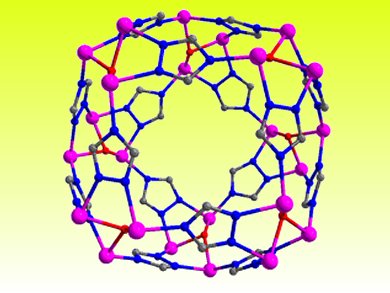Metallamacrocycles (MMCs) are a special class of polynuclear complexes with ringlike shapes. Most MMCs are assembled through bridging mononuclear metallic centers; construction of polymetallic-cluster-based MMCs is still a great challenge.
C.-M. Liu and co-workers, Beijing National Laboratory for Molecular Sciences, China, report a nanoscale [Co24] metallamacrocycle constructed from eight Co3(MeOH)–p–tert-butylsulfonylcalix[4]arene (TBSOC) subunits and 16 1,2,4-triazolate (trz–) bridging ligands, [Co24(TBSOC)8(trz)16(CH3OH)8]•28H2O•14CH3OH (1, pictured below, nestlike core shown above).

MMC (1) contains trinuclear cobalt–calixarene subunits that are further linked together by trinucleating trz– bridges to form an unusual square antiprism polyhedron topology. It is the largest cluster complex found to date to be supported by the TBSOC4– ligand, and magnetism studies confirm that it shows antiferromagnetic properties.
Images: © Wiley-VCH
- Nestlike C4-Symmetric [Co24] Metallamacrocycle Sustained by p-tert-Butylsulfonylcalix[4]arene and 1,2,4-Triazole
C.-M. Liu, D.-Q. Zhang, X. Hao, D.-B. Zhu,
Chem. Eur. J. 2011.
DOI: 10.1002/chem.201101607



